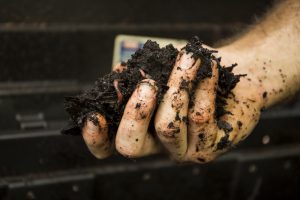We get a lot of questions from folks dealing with plant and pest issues in their landscape about “what to spray”, or “how to fertilize”. Often times we want the quick fix. What if there was more to having a thriving landscape than applying the right amount of irrigation, fertilizer, and pesticide. How did plants survive before the advent of modern gardening? The thing that most our plants have in common is that they need soil. We don’t realize how complex soil is. A healthy soil not only contains soil particles, and nutrients but there is a very vibrant living component to our soils as well. Yes, that is right, our soils are alive. They contain a diverse community of beneficial organisms that work together that include fungi, bacteria, insects, and nematodes that is often called the food web. While we often think of fungi, insects and nematodes as bad things to have in the soil, most of them are beneficial in many ways.
Most fungi in the soil are not disease producers. They are the only microbe that can break down lignin allowing leaves and dead wood to decompose adding organic matter. Without them our landscapes would fill up with dead leaves and fallen branches. Another important group of fungi are called mycorrhizae. Mycorrhizae means “fungus roots”. Mycorrhizae help plant roots to be more efficient in absorbing nutrients and water by extending filaments into the soil while being anchored to the roots. Mycorrhizae can also form a protective shield around the roots protecting them from disease causing fungi, and harmful nematodes. Mycorrhizae also help to bind soil particles together creating helpful soil structure.

Photo Credit: UF/IFAS Photo by Camila Guillen
Soil bacteria are also a big component of a healthy soil. They help to break down wood and plant material further so that plants roots can harvest the nutrients. The heat in a compost pile is caused by those healthy bacteria helping to break down the organic matter into materials plants can use. Nitrogen fixing bacteria live near roots and provide nitrogen to the plant roots.
Soil arthropods such as mites, springtails and millipedes help by consuming organic matter, and harmful fungi, along with shedding their own organic matter.
Nematodes are microscopic roundworms that are most associated with damaging plant roots. In addition to the harmful nematodes there are a host of nematodes that feed on disease causing fungi, bacteria, and even other harmful nematodes. They help to keep the harmful nematodes in check.
We are all familiar with the soil boosting role that earthworms play consuming organic matter and producing castings that increase organic matter. Their tunneling and burrowing also help improve the soil structure. Earthworms are often the indicators of a healthy soil. A lack of earthworms often indicates a lack of soil microbes that the earthworms feed on.
There are several practices that residents can do to promote a “living” soil and therefore a healthier soil. They include:
- Build up the organic matter in the soil by adding compost. Another way is to allow grass clippings to fall back on the lawn while mowing. Aim to build the soil’s organic matter level up to 5%–10% to support a healthy soil food web.
- Increase the diversity of plant material throughout the landscape, including the lawn. Concentrating on planting a greater variety of plants can make your landscape more resistant to disease.
- Cover exposed soil using mulch, grass, ground covers, or cover crops throughout the landscape. This keeps the soil cooler and supports more of the soil flora and fauna.
- Minimize soil disturbance. Driving over the soil can compact it reducing the pore space for roots and tilling can disturb soil mycorrhizae by drying them out.
- Cultivate living roots throughout the soil. These living roots sluff off material as they grow (think of dry skin) that helps to feed soil microbes. Having a diverse variety of roots can help supply a more diverse community of microbes.
- Test the soil before adding fertilizer. The overapplication of fertilizer can inhibit the natural soil organisms.
- Use organic fertilizer sources, when possible, to support the soil microbes when nutrients are needed. Organic fertilizer sources often need microbes to help them release nutrients. The nutrients are released more slowly providing nutrients for a longer time and not contributing to runoff and leaching.
- Inoculate the soil with beneficial microorganisms. They can be purchased but also can be added through topdressing with compost as it also commonly contains beneficial microbes.
Creating a healthy soil is a sustainable way for us to grow productive landscapes. All we have to do is to look at natural landscapes to use as role models. Forests fields and meadows do fine on their own without our help. If we can create a favorable habitat for soil organisms in our landscapes perhaps, our landscapes can thrive with less inputs from us. Therefore allowing us more time to enjoy them. For more information on creating a healthy landscape soil go to: https://edis.ifas.ufl.edu/publication/SS664
 0
0
